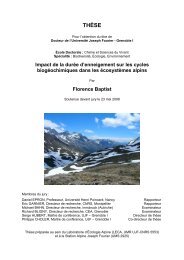2nd International Congress of Alpine and Arctic Botanical Gardens
2nd International Congress of Alpine and Arctic Botanical Gardens
2nd International Congress of Alpine and Arctic Botanical Gardens
Create successful ePaper yourself
Turn your PDF publications into a flip-book with our unique Google optimized e-Paper software.
Kew’s <strong>Alpine</strong> House – what’s the point?<br />
Katie PRICE<br />
Royal Botanic <strong>Gardens</strong> Kew, United Kingdom<br />
A general question is why we should use our limited resources to grow <strong>and</strong> display alpine plants in a lowl<strong>and</strong><br />
botanic garden. The talk explores the work <strong>of</strong> the <strong>Alpine</strong> <strong>and</strong> Rock Garden units at the Royal Botanic<br />
<strong>Gardens</strong>, Kew, explains the technology behind the new Davies <strong>Alpine</strong> House <strong>and</strong> shows some <strong>of</strong> the l<strong>and</strong>scaping<br />
<strong>and</strong> cultivation techniques both in the nursery <strong>and</strong> the display house.<br />
At a congress for gardens situated at<br />
high altitudes, which <strong>of</strong>fer optimum conditions<br />
for the cultivation <strong>of</strong> a huge range <strong>of</strong> plants, the<br />
obvious question is, what is the point <strong>of</strong> trying to<br />
grow alpines in a lowl<strong>and</strong> garden such as Kew?<br />
There are many obstacles to successful cultivation<br />
at Kew: the increasingly warm, dry summers<br />
<strong>of</strong> south-east Engl<strong>and</strong> mean that many<br />
<strong>of</strong> the plants have to survive temperatures far<br />
beyond their natural limits; the mild, wet winters<br />
threaten those which, in their native habitats,<br />
spend up to nine months in cool, dry dormancy,<br />
wrapped in a protective blanket <strong>of</strong> snow.<br />
But there are five compelling reasons to maintain<br />
an alpine collection at Kew: duty, beauty, science,<br />
education <strong>and</strong> horticulture.<br />
First, duty: as the national botanic garden for<br />
Engl<strong>and</strong>, Kew is obliged to maintain a national<br />
botanical reference collection, representing as<br />
many plant families as possible from as many<br />
parts <strong>of</strong> the globe as possible. Mountains cover<br />
25% <strong>of</strong> the world’s l<strong>and</strong>mass, so the mountain<br />
flora is a critical part <strong>of</strong> that reference collection.<br />
Even if it were the only justification, then surely<br />
beauty would be reason enough. The diverse<br />
beauty <strong>of</strong> the mountain flora is explored through<br />
four distinct areas in the north-eastern zone <strong>of</strong><br />
the <strong>Gardens</strong>: the Woodl<strong>and</strong> Garden, which concentrates<br />
on herbaceous woodl<strong>and</strong> plants; the<br />
Rock Garden; the <strong>Alpine</strong> House <strong>and</strong> the <strong>Alpine</strong><br />
Nursery. The alpine collections contain dramatic<br />
species from six continents. South American<br />
flora includes plants from the barren, windswept<br />
upl<strong>and</strong>s <strong>of</strong> Patagonia – Petunia patagonica <strong>and</strong><br />
Calceolaria uniflora, the extraordinary Leontochir<br />
ovallei from the coastal mountains <strong>of</strong> Chile’s<br />
Atacama Desert; from New Zeal<strong>and</strong> comes<br />
Education Concepts 39




